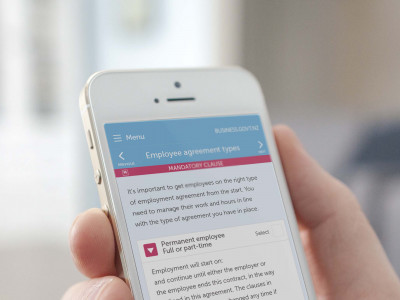The Role of Digital Product Development in Digital Transformation
We've come to the final piece in our ongoing series on the Four Ps of Digital Transformation. In this article we discuss the importance of building an effective product design and delivery process to enable digital transformation.
While the other elements we've discussed in the series (People, Process and Platform) have critical roles to play in digital transformation, perhaps no other element is as crucial as product.

Digital product design - at the heart of digital transformation
All organisations - regardless of size or industry - are affected by digital technology. Digital products can completely revolutionise a market (e.g. Uber, Mobile payments, peer to peer lending), or simply optimise an existing process or service (e.g. B2B online ordering portal, CRM integration or online booking capability).
Your product is ultimately the piece of the puzzle that your customers will directly engage with so an effective digital product design and delivery process is a critical capability for businesses wanting to remain competitive.
Designing and delivering quality digital products at pace is key to staying competitive
The need for digital transformation for retailers and service organisations is relatively self-evident - competition from online outlets has increased the pressure on businesses to optimise their feature set.
With less-obvious candidates for digital transformation, the journey may not be as clear. However, consultants can work closely with organisations in all sectors to help embed digital thinking into product and service design.
Aligning digital product design with business strategy
The digital product roadmap should align closely with your business objectives and strategies. Product teams working in isolation in "innovation labs" are unlikely to bring real change to the business performance.
McKinsey & Company notes that organisations such as Amazon, Facebook, and Google encourage product managers to think about complete digital experiences - how can the whole customer interaction be optimised through digital?
Rather than seeing new digital products as stand-alone products that are developed away from the organisations core products or services, it's more effective to develop digital products that leverage the core business assets and customer base effectively.
For most enterprises, developing and monetizing stand alone digital products is a high risk investment. With limited resources, it's better to leverage digital technology to improve your existing product or service experience.
Understanding your market
Developing digital products requires a good understanding of both your customers and your market. By combining customer research, online feedback, expert review and real time and analytics, businesses can design better products that generate customer engagement and loyalty.
How many of your users are engaging with digital products and services already? Across which platforms? Using which device types? How can you incentivise your non-digital customers to engage with digital channels?
Undertaking preliminary offline research can help shape the market opportunity and create a business case for digital product investment.
Involving your customers in the design process from the outset ensures a better user experience
For enterprises operating at scale, it may be difficult to see how digital innovation can be applied to the operation.
In our experience, to remain relevant and competitive, every business needs to really understand how digital technologies are affecting their business and have an active digital transformation programme.
Key ways to develop better digital products, faster
1. Involve customers in the design process from the outset
2. Obtain feedback from right across the organisation, not just the design / tech teams
3. Use data and analytics to make decisions wherever possible
4. Keep product designs at prototype stage and keep iterating until you're confident to employ development resource
5. Use A/B testing when possible to improve conversion
6. Give customers a clear way to provide feedback
7. Bring in external UX / Product consultants to provide independent input
The influence of global platform providers on digital product development
Customer expectations have evolved rapidly through their interactions with digital experiences delivered by well-funded global platform providers like Facebook, Google, Uber, Amazon, AirBnB and Apple. With large R&D, innovation and product development teams, it's clear that these businesses are investing heavily in digital product development.
While the level of investment and pace of change presents challenges, it also presents opportunities. There are emerging standards in product design that can be lifted and shifted from global players that have already researched effective product designs. Examples include navigation methods, check-out processes, opt-in registrations, social sharing, gamification and social integration.
What makes a great digital product?
As the interface between your organisation and your customers (whether consumers, suppliers, business partners or staff), your whole operation will be ultimately judged by the quality of your digital product.
Your customers will be looking at the following factors:
- Can I achieve my main goals quickly and simply?
- Is the experience personal and relevant?
- Are the interaction methods intuitive and similar to other digital products I interact with frequently?
- Does the product learn about my behaviour and preferences?
- Is my experience seamless across multiple devices and channels?
- Does the product deliver a surprise and delight factor?
- Are there any smart features that enrich the experience (like geo-location, social and API integration, personalisation based on my device content)?
Speed to market is critical
Developing a digital product that stands out in today's competitive market requires both speed and agility.
Documenting detailed requirements traditionally required for large-scale IT projects using waterfall methodology will not help produce innovative products at pace. Creating highly innovative projects requires the project team to be able to change, discuss and debate product features in-flight, develop light weight prototypes rapidly, share and test experiences.
Agile methodology brings the customer into the design process early and establishes a consistent feedback loop to help drive product features and attributes, leading to a much better final product. Traditionally, the entirety of the development process was mapped out in advance, but agile teams have an improved ability to pivot and get things moving as rapidly as possible.
Through a much more agile development process, our clients are experiencing the benefits of their digital products faster.
Traditional businesses often lack the expertise to achieve these outcomes on their own, so we collaborate with internal teams to nurture and build an effective digital product development capability.
Solnet's team of consultants and developers can help deliver real digital change.

